Pippa’s Big Guide To The Best Puppy Toys You Can Buy
The best puppy toys for Labs and other large breed dogs have to be really tough to last more than a few weeks. Good puppy toys are not cheap, and my puppies are very hard on their toys. I find that puppies like to chew on materials with different textures so you’ll need to buy several different types of toy.
In This Guide
I have not included a table comparing lists of toys, or quoting reviews written by other people. You can find those on Amazon. Instead show you exactly which toys I buy for my puppies.
- Toys for puppies to snuggle up to
- Hard rubber puppy toys (and their limitations)
- Wood toys for puppies that chew furniture
- Antlers and bones
- My pick of the best toys for puppies
I look at which toys they prefer, and at how long those toys stand up to the rough treatment my dogs give them.
You’ll find a lot of the toys discussed below are produced by the Kong toy company, simply because I think they are better than most of the others. I have been a fan of Kong dog toys for many years now, and have several dogs that have grown up with them.
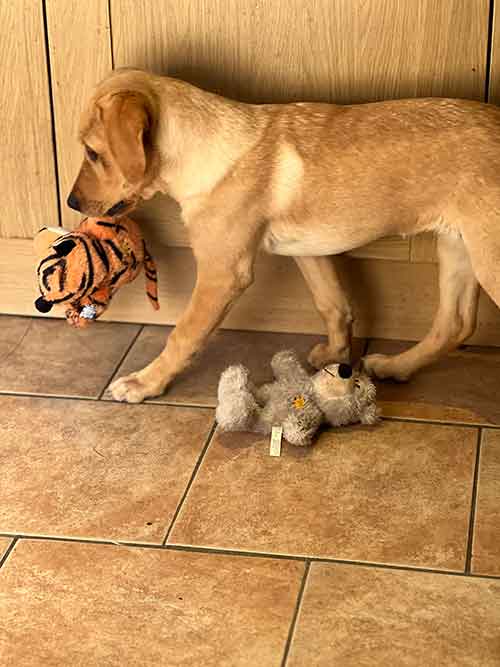 (paid link)
(paid link)I do not get compensation from the manufacturer and the opinions you’ll find here are entirely my own. There are, however, some amazon links in this article and we earn a small commission from Amazon (at no extra cost to you) if you make a purchase through them.
Toys to snuggle up to
There’s nothing cuter than a puppy curled up with their favorite teddy bear. And a teddy or some other soft toy is often the first thing that people buy for their new puppy.
I have found the Kong range of soft toys to be tougher and more durable than any other. But no soft toy is entirely indestructible.
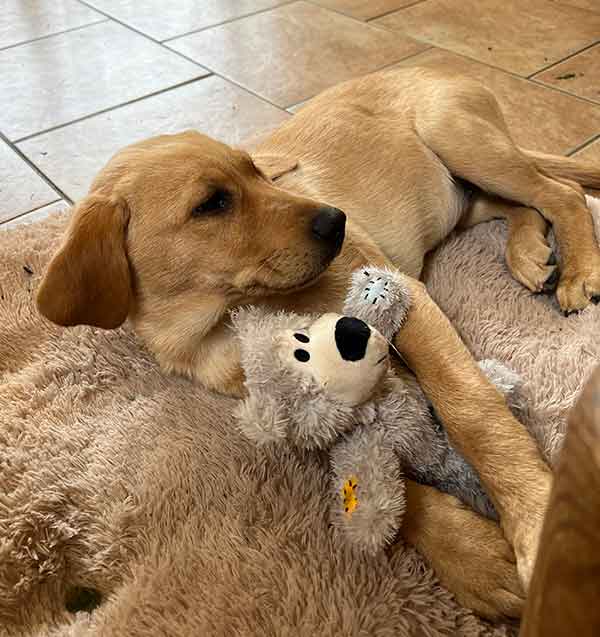 (paid link)
(paid link)The lifespan of a dog’s teddy is often a short one! It’s best not to buy a soft toy expecting to pass it down from one puppy to the next. If your new puppy still has the same toy by the time they are six months old, that’s great, but also fairly unusual.
The Kong Wild Knots Range
The toys in this section are mainly from the Kong Wild Knots range(paid link). They have minimal stuffing and the cavity of the toys contain strong, pliable knotted ropes.
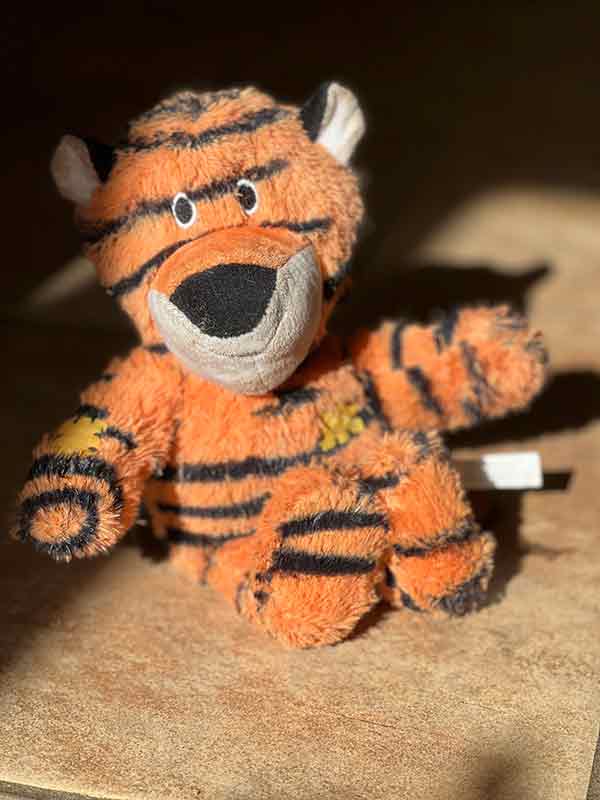 (paid link)
(paid link)This provides a great chewing experience for young puppies and I find it helps to reduce their enthusiasm for chewing on other soft items such as your fingers, or the expensive bed you just purchased for them.
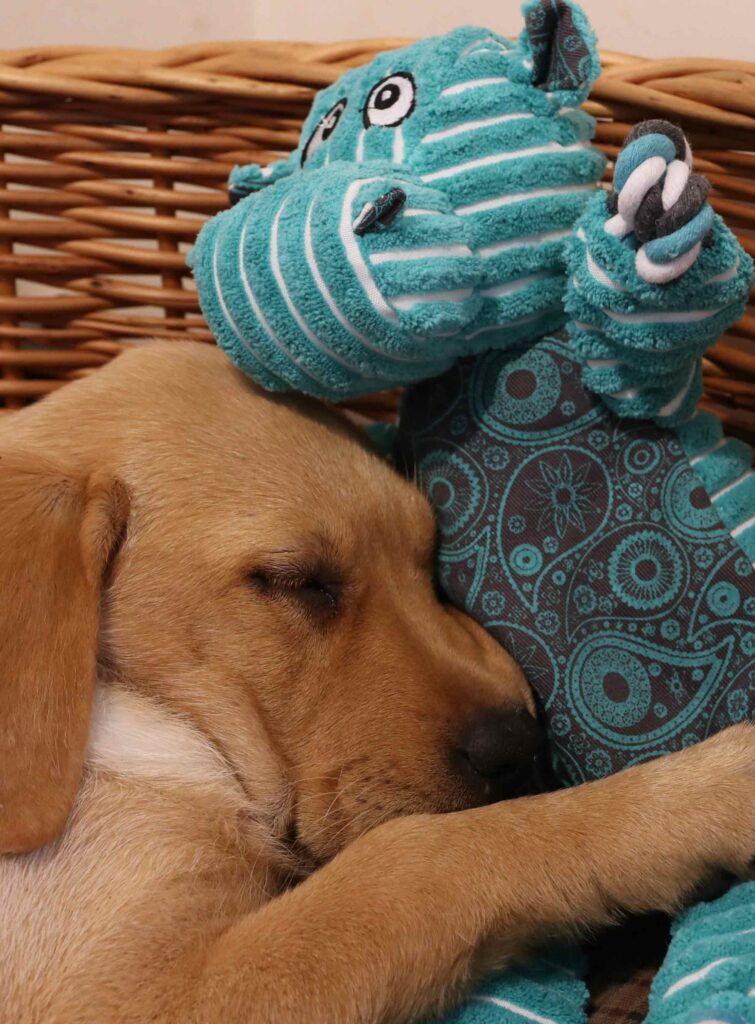 (paid link)
(paid link)My Labrador puppy Bonnie has a lot of these toys and really loves to play with the ones with the ribbed exterior like as the hippo above, and the elephant or rabbit(paid link) in the same style.
The Kong cross knots toys are a bit more cuddly and just perfect for nap time! Bonnie has the lion. But you can also buy a cute blue monkey in the same design.
Kong Wubbas
The wubba range fulfils the same role as the more durable soft toys. They look a bit like an octopus with trailing legs made from a fairly tough canvas type material. The head is covered in the same fabric and contains a rubber ball with a squeak inside.
Kong Wubbas come in both large, and puppy sizes. Bonnie still has her puppy wubba and its the only soft toy she has, that she’s allowed to take in the garden, so it does get some rough treatment.
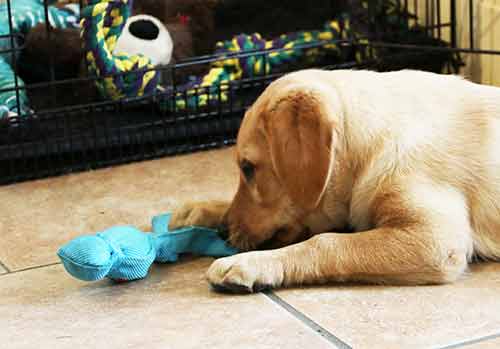
However, most of my dogs have destroyed their Wubbas within a couple of months. The head is the vulnerable part and once the dog has broken through that, you need to remove the toy as the inner plastic ball is not chew proof.
Can you stop a puppy destroying their plushies?
The teddies in the Kong range are gorgeous and very cuddly for tiny puppies to sleep against. They are perhaps a little less tough than the elephant and hippo, and my terrier had disassembled hers by about six months of age.
Bonnie, however, has several Kong teddies and they have all survived the first six months. It very much depends on your individual dog.
I think its important to be realistic and accept that you can’t prevent puppies destroying these soft toys altogether.
What you can do is reduce the risk of damage in a few ways.
One way is to choose toys by a quality manufacturer like Kong. They are a bit more expensive, but I have found them to be much tougher than most other brands.
Another way is to make sure you introduce the toys at an early age.
Introduce soft toys as soon as possible
An 8 week old puppy is less likely to rip their new teddy up than a 12 week old puppy. The older pup is a more determined chewer and will usually attempt to find out what’s inside any new toy.
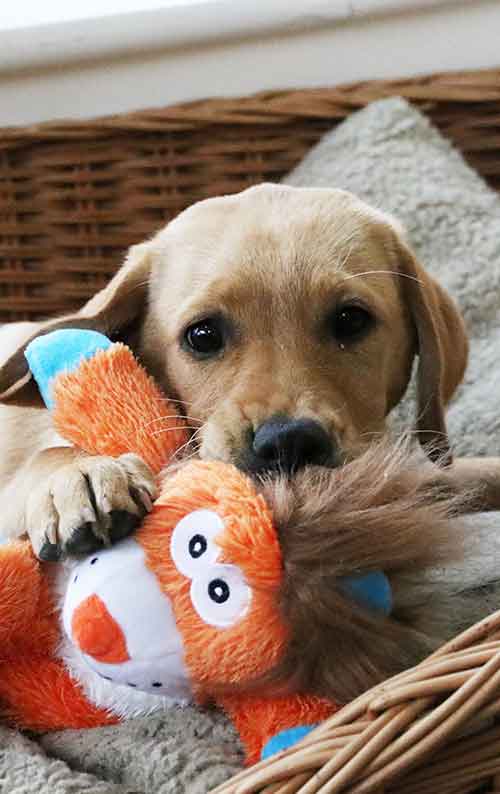
If your puppy has had the toy since they were tiny, they are going to be less likely to explore its contents and may even keep the toy intact for months.
Mend any holes promptly
If you see a small hole appearing in a soft toy, and you mend it promptly, you may get a few more weeks out of it.
Once the puppy has discovered the joys of pulling the stuffing out, you have probably lost the battle.
Buy toys with minimal stuffing
The toys in the Kong Knots range have minimal stuffing. And you can buy toys with no stuffing at all.
The problem with stuffed toys for puppies is two fold. Firstly it encourages the dog to pull out the contents, and secondly, some puppies will swallow it.
So if mending is not your thing, it’s best to throw the toy once the stuffing starts to come out.
Multiple toys can help
Bonnie is quite spoiled with the number of toys she has, but I find it helps increase the lifespan of soft toys if I buy an assortment.
It seems that with just one soft toy, the puppy can get very focused on it and is more likely to worry at the toy, until it starts to come apart
Why bother with soft toys
So if soft toys are not very durable, why bother with them at all? Why not just get your puppy chew toys?
Well puppies do actively seek out a variety of surfaces to chew on, and chewing on softer more pliable items seems to meet an important need. They find it relaxing and it takes the pressure off their bedding.
I guess it’s a similar sensation to chewing on the skin or sinew of a prey animal that would be a puppy’s natural food source.
When to throw soft toys away
Once soft toys start to come apart, they are no longer safe for your puppy. So you need to either mend them, or discard them.
In addition, once a puppy discovers that one soft toy comes apart, they’ll often try to get the same result with the others, so that’s another good reason to remove toys as soon as they are torn or damaged.
The best soft toy for puppies
I recommend the Kong knots elephant and the Kong Knots teddy (large size) for a Labrador puppy. These toys also come in smaller sizes for small breed dogs. Bonnie is six months now and hers are still both in good shape. She’s had them since she was 9 weeks old.
Tough puppy chew toys
The toys in this section are designed for puppies to chew on and play with. They are usually made of strong rubber and are close to indestructible. My older dogs love each of the toys in this section. Some of them, they have had for years.
Puppies on the other hand, tend to have a limited interest in these hard rubber toys, and you’ll usually need to engage with your puppy or add food to the toy, in order to get full use of it.
These are the ones that Bonnie likes the best
Kong red bone(paid link), the kong ring(paid link), and the filled puppy kong(paid link)
Why some puppies may need wood chews
We have talked about the fact that puppies need a variety of surfaces and textures to chew on, and this is particularly relevant when it comes to puppies that love to chew on wood.
It’s frustrating when your puppy prefers the kitchen table legs to the nice chew toys that you bought for them. But the fact is, for many puppies, rubber chew toys don’t really satisfy the need to chew on something hard. And some puppies seem to have a really strong need to bite on wood.
If you’ve got a puppy that makes a beeline for your baseboards every time your back is turned, then you might want to provide them with something wooden to chew on. And it can be hard to find anything around your home and yard that fulfils that need without splintering and being swallowed. That’s where tree root chews come in.
These are (relatively) safe wooden chews are made from a specific kind of tree root that is very tough and doesn’t splinter. They are not cheap but they are very durable and provide puppies with hours of happy chewing.
If your puppy is keen on chewing furniture or wooden fixtures and fittings in your home, then a chew root or tree root toy will almost certainly help. However, we can’t talk about giving puppies hard chew toys without talking about the risks as well as the benefits.
The risks of chewing harder toys
Just like people, dogs sometimes break their teeth and when this happens it is painful for the dog, and expensive to fix. Dental surgery for dogs requires a general anaesthetic which adds to the risk. And chewing hard objects may be implicated in this risk.
Tooth fractures are not uncommon in dogs and in a four year study carried out in 1999 more than a quarter of the five thousand dogs treated for dental problems, had fractured a tooth. Reported causes of tooth fractures in another study , include playing, catching hard objects such as stones or heavy branches, and hunting.
Peak age for tooth fractures is not puppies, but rather older dogs more likely to be engaged in vigorous play. I can’t find any data that quantifies the risks of chewing on harder toys but it seems reasonable to assume that there may be some risk attached to giving your dog a wood chew, and you need to be aware of that.
Be aware also, that these chew roots are heavy. If (when) your puppy drops theirs on your toes, it hurts!
Antlers and bones
Harder still than wood chews are actual bones and chews made from deer antlers. Antlers and weight bearing bones of large animals such as cows and sheep are available for sale to dog owners, and some vets are concerned about the risk of tooth fractures in dogs that are given these items as chew toys.
Many vets recommend eliminating any hard chew toys altogether, and replacing them with toys that have some ‘give’ or bend to them. The thumbnail test (can you make a dent in the toy with your thumbnail) can be used to separate hard toys from toys that most vets consider more appropriate.
I followed this protocol myself for quite some time, but have recently returned to providing my dogs with antlers to chew on. I’m not recommending that you do the same, but I’ll explain why I made this decision for my own dogs.
One reason is the lack of effective alternatives.
Many items (usually made from rubber) sold as chew toys for dogs have little appeal to them for ‘chewing’. Dogs will play with them for a bit, especially if you join in. And they’ll chew on them for a short while, before losing interest.
Most dogs enjoy natural rawhide chews and other similar items such as pigs ears too. But I find they break up too quickly and often make dogs vomit after swallowing the bits. The vomiting itself probably isn’t harmful, but it’s unpleasant indoors!
My older dogs like to run around with their rubber toys, and will sometimes play tug with each other with their Kong rings. But they don’t lie down and chew on them for long periods of time. And puppies often don’t have much interest in them. So they are simply not an alternative to hard materials like wood, antler and bone.
So, does it really matter if dogs don’t have anything hard to chew?
The need to chew
In the many years that I’ve been raising dogs, I have observed that chewing is a significant source of pleasure for them. I’d go so far as to say that recreational chewing is a physical need for many dogs. And that they find it deeply relaxing.
My dogs are fed on a raw diet and get plenty of bones as part of their daily food rations. Even so, they still get a lot of pleasure by relaxing with an antler afterwards. And I want them to experience this pleasure as many of my dogs have done before them over the years.
Less destructive behavior
All puppies can be destructive, in that they chew and tear up things you don’t want them to chew. Many puppies will chew baseboards and walls as well as furniture in order to bite down on something hard.
And yes, frozen filled Kongs go some way to help, but the only way to completely avoid inappropriate chewing is to watch the puppy constantly, or to crate or pen the puppy in such a way that they can’t chew anything that you don’t approve of.
However, I find that opportunities for recreational chewing of something that the dog really values, such as bones or antlers, greatly reduces inappropriate chewing, and helps puppies to relax. And this is the main reason that I have gone back to providing my puppies and dogs with bones and antlers for recreational chewing.
Whether or not you want to take this risk may depend on your own situation and how your puppy settles and behaves with their toys. It’s definitely worth trying alternatives first. And talking to your veterinarian as new products come onto the market all the time.
Clean teeth
If your dogs are fed on kibble, chewing bones and antlers may help to keep their teeth clean.
A study showed that chewing on bones reduced dental calculus in a group of eight beagles quite effectively: an 88% reduction after twenty days. This is certainly something I have seen in my own dogs when I switched to raw food.
An alternative promoted by the veterinary profession is brushing your dog’s teeth in the same way that you brush your own each day. Unfortunately vets are struggling to persuade the dog owning population to take up this practice. I’m not sure why we are so reluctant to clean our dog’s teeth, but perhaps that’s a topic for another day!
My pick of the best puppy toys
Here are the top five toys I buy and recommend for any new puppy.
- Kong Wild Knots Teddy(paid link)
- Kong Floppy Knots Elephant (or Hippo)(paid link)
- Original classic Kong(paid link)
- Chew Root(paid link)
- Kong Ring(paid link)
The small size teddy is really small, so for a Lab puppy I’d go for the large one, that’s Bonnie’s dark brown teddy in the photos above. It’s very light and even an eight week old puppy can carry it around.
The same with the elephant and hippo though if your budget will stretch, puppies enjoy the little versions of this type of toy such as Bonnie’s rabbit, as they like throwing them around.
The original kong is the toy that started the Kong company on the road to success. It can be filled with mushy food and frozen, and then given to your puppy when you crate them for a little while. I have a few of these.
You can buy a puppy version, and I did do this for my terrier. But for the other dogs I used the full size adult Kong from the start. You can also buy an even stronger version – the black kong – for power chewers like Pitbulls.
Multiple dogs and puppy toy jealousy
Just a quick additional note if you have older dogs alongside your puppy, beware of toy jealousy. I sometimes see people complaining that their older dog won’t share, and keeps stealing the puppy’s toys.
I just want to make it clear that dogs have no concept of sharing and toys are either ‘mine’ or ‘not mine’ with possession being the founding principle of ownership.
Your dog is not selfish for wanting the puppy’s teddy, and if you buy them one each, that may help, but the chances are your older dog will want them both!
You are in for a massive battle if you try to teach your older dog not to touch the puppy’s toys so I recommend you simply keep these out of the older dog’s reach in a puppy playpen or crate. That way the puppy can enjoy them undisturbed when they are resting.

Free Labrador Updates!
Get my training tips, news, reviews, and the latest from The Labrador Site delivered to your inbox

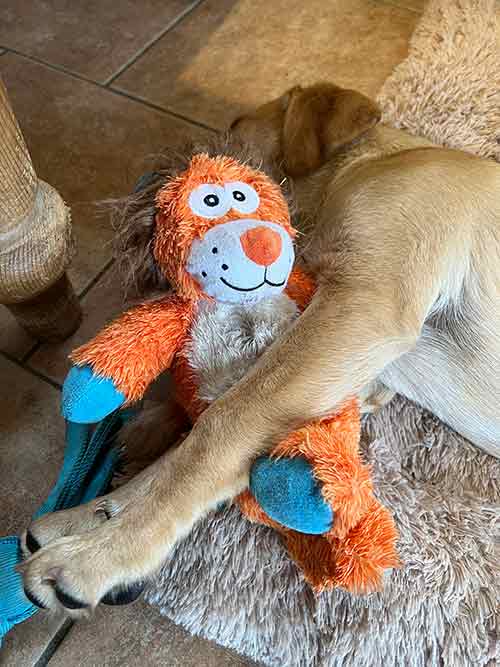
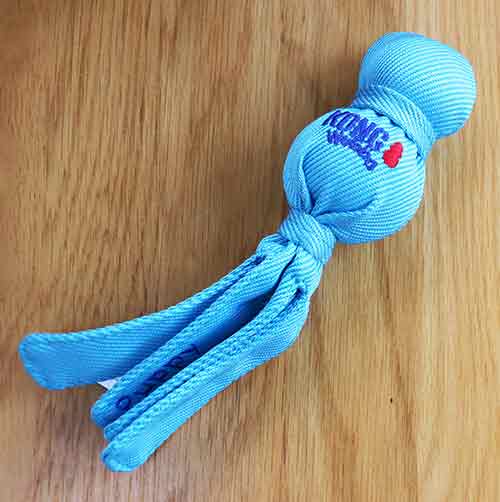
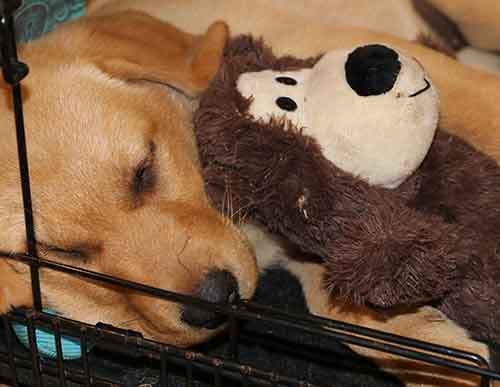
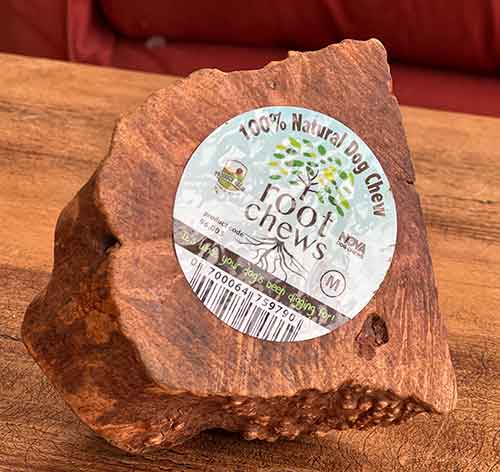

Aussie Dog Products are exceptional – safe and tough. They make toys for zoo animals as well! We sent my sister a “Puppy Pack” (large for Labradors). The quality looked so good, we wound up buying ten more different toys! Most of them float, which is great for a Lab. The “Bungee Chook” especially looks like a lot of fun for home alone play. We figured in the long run it was cheaper to buy one good quality toy, than keep on buying cheap toys that were destroyed (and unsafe). You definitely get what you pay for in this case – well worth the money!
I have a schnoodle puppy, six and a half mo.old. She has hewed a part off of those nylon bones with the little teeth on them, colored pink or blue. She rips right through the rope type chew toys and it seems she will chew anything, if I don’t keep an eye on her. I need a solution to her chewing. All adult teeth are now in place. Any suggestions would be helpful.